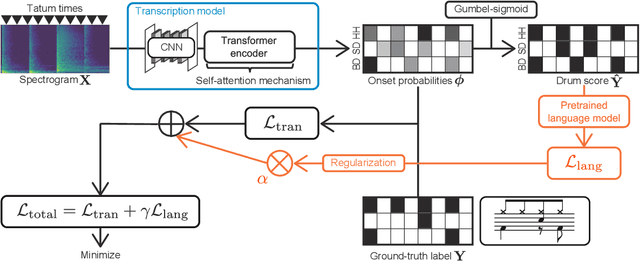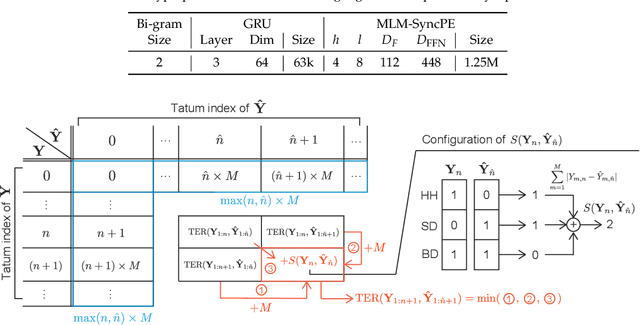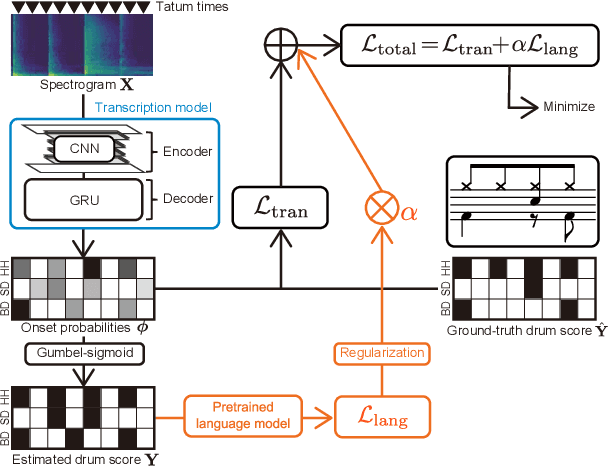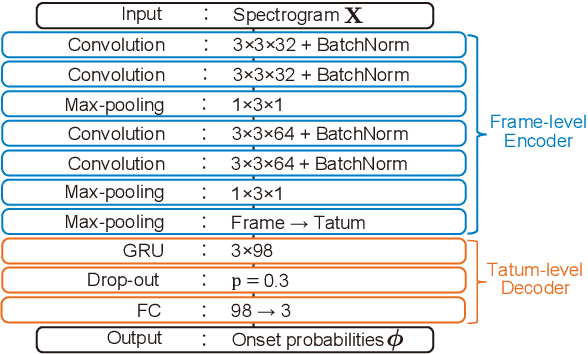Ryoto Ishizuka
Global Structure-Aware Drum Transcription Based on Self-Attention Mechanisms
May 12, 2021



Abstract:This paper describes an automatic drum transcription (ADT) method that directly estimates a tatum-level drum score from a music signal, in contrast to most conventional ADT methods that estimate the frame-level onset probabilities of drums. To estimate a tatum-level score, we propose a deep transcription model that consists of a frame-level encoder for extracting the latent features from a music signal and a tatum-level decoder for estimating a drum score from the latent features pooled at the tatum level. To capture the global repetitive structure of drum scores, which is difficult to learn with a recurrent neural network (RNN), we introduce a self-attention mechanism with tatum-synchronous positional encoding into the decoder. To mitigate the difficulty of training the self-attention-based model from an insufficient amount of paired data and improve the musical naturalness of the estimated scores, we propose a regularized training method that uses a global structure-aware masked language (score) model with a self-attention mechanism pretrained from an extensive collection of drum scores. Experimental results showed that the proposed regularized model outperformed the conventional RNN-based model in terms of the tatum-level error rate and the frame-level F-measure, even when only a limited amount of paired data was available so that the non-regularized model underperformed the RNN-based model.
Tatum-Level Drum Transcription Based on a Convolutional Recurrent Neural Network with Language Model-Based Regularized Training
Oct 08, 2020



Abstract:This paper describes a neural drum transcription method that detects from music signals the onset times of drums at the $\textit{tatum}$ level, where tatum times are assumed to be estimated in advance. In conventional studies on drum transcription, deep neural networks (DNNs) have often been used to take a music spectrogram as input and estimate the onset times of drums at the $\textit{frame}$ level. The major problem with such frame-to-frame DNNs, however, is that the estimated onset times do not often conform with the typical tatum-level patterns appearing in symbolic drum scores because the long-term musically meaningful structures of those patterns are difficult to learn at the frame level. To solve this problem, we propose a regularized training method for a frame-to-tatum DNN. In the proposed method, a tatum-level probabilistic language model (gated recurrent unit (GRU) network or repetition-aware bi-gram model) is trained from an extensive collection of drum scores. Given that the musical naturalness of tatum-level onset times can be evaluated by the language model, the frame-to-tatum DNN is trained with a regularizer based on the pretrained language model. The experimental results demonstrate the effectiveness of the proposed regularized training method.
 Add to Chrome
Add to Chrome Add to Firefox
Add to Firefox Add to Edge
Add to Edge